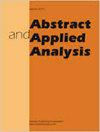Control of the Cauchy System for an Elliptic Operator: The Controllability Method
Q3 Mathematics
引用次数: 0
Abstract
In this paper, we are dealing with the ill-posed Cauchy problem for an elliptic operator. This is a follow-up to a previous paper on the same subject. Indeed, in an earlier publication, we introduced a regularization method, called the controllability method, which allowed us to propose, on the one hand, a characterization of the existence of a regular solution to the ill-posed Cauchy problem. On the other hand, we have also succeeded in proposing, via a strong singular optimality system, a characterization of the optimal solution to the considered control problem, and this, without resorting to the Slater-type assumption, an assumption to which many analyses had to resort. On occasion, we have dealt with the control problem, with state boundary observation, the problem initially analyzed by J. L. Lions. The proposed point of view, consisting of the interpretation of the Cauchy system as a system of two inverse problems, then called naturally for conjectures in favor of which the present manuscript wants to constitute an argument. Indeed, we conjectured, in view of the first results obtained, that the proposed method could be improved from the point of view of the initial interpretation that we had made of the problem. In this sense, we analyze here two other variants (observation of the flow, then distributed observation) of the problem, the results of which confirm the intuition announced in the previous publication mentioned above. Those results, it seems to us, are of significant relevance in the analysis of the controllability method previously introduced.椭圆算子考奇系统的控制:可控性方法
本文研究一类椭圆算子的病态柯西问题。这是前一篇关于同一主题的论文的后续。事实上,在早期的出版物中,我们介绍了一种正则化方法,称为可控性方法,它允许我们提出,一方面,病态柯西问题的正则解的存在性的表征。另一方面,我们还通过一个强奇异最优性系统,成功地提出了所考虑的控制问题的最优解的特征,而这没有诉诸于slater类型的假设,这是许多分析不得不诉诸的假设。有时,我们处理控制问题,用状态边界观察,这个问题最初是由J. L. Lions分析的。所提出的观点,包括将柯西系统解释为两个逆问题的系统,然后自然地提出了支持本手稿想要构成论点的猜想。事实上,鉴于获得的最初结果,我们推测,从我们对问题的最初解释的角度来看,所提出的方法可以得到改进。从这个意义上说,我们在这里分析了问题的另外两个变体(流的观察,然后是分布式观察),其结果证实了上面提到的先前出版物中宣布的直觉。在我们看来,这些结果与先前介绍的可控性方法的分析具有重要的相关性。
本文章由计算机程序翻译,如有差异,请以英文原文为准。
求助全文
约1分钟内获得全文
求助全文
来源期刊
CiteScore
2.30
自引率
0.00%
发文量
36
审稿时长
3.5 months
期刊介绍:
Abstract and Applied Analysis is a mathematical journal devoted exclusively to the publication of high-quality research papers in the fields of abstract and applied analysis. Emphasis is placed on important developments in classical analysis, linear and nonlinear functional analysis, ordinary and partial differential equations, optimization theory, and control theory. Abstract and Applied Analysis supports the publication of original material involving the complete solution of significant problems in the above disciplines. Abstract and Applied Analysis also encourages the publication of timely and thorough survey articles on current trends in the theory and applications of analysis.

 求助内容:
求助内容: 应助结果提醒方式:
应助结果提醒方式:


